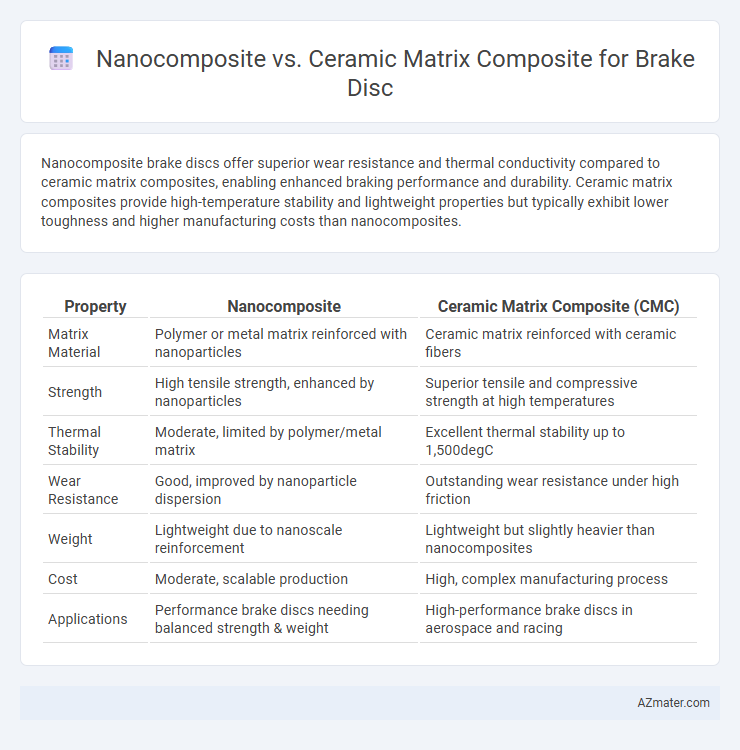Nanocomposite brake discs offer superior wear resistance and thermal conductivity compared to ceramic matrix composites, enabling enhanced braking performance and durability. Ceramic matrix composites provide high-temperature stability and lightweight properties but typically exhibit lower toughness and higher manufacturing costs than nanocomposites.
Table of Comparison
| Property | Nanocomposite | Ceramic Matrix Composite (CMC) |
|---|---|---|
| Matrix Material | Polymer or metal matrix reinforced with nanoparticles | Ceramic matrix reinforced with ceramic fibers |
| Strength | High tensile strength, enhanced by nanoparticles | Superior tensile and compressive strength at high temperatures |
| Thermal Stability | Moderate, limited by polymer/metal matrix | Excellent thermal stability up to 1,500degC |
| Wear Resistance | Good, improved by nanoparticle dispersion | Outstanding wear resistance under high friction |
| Weight | Lightweight due to nanoscale reinforcement | Lightweight but slightly heavier than nanocomposites |
| Cost | Moderate, scalable production | High, complex manufacturing process |
| Applications | Performance brake discs needing balanced strength & weight | High-performance brake discs in aerospace and racing |
Introduction to Advanced Brake Disc Materials
Nanocomposites and ceramic matrix composites (CMCs) represent cutting-edge materials designed to enhance brake disc performance through improved thermal stability and wear resistance. Nanocomposites incorporate nanoscale fillers such as carbon nanotubes or graphene, offering superior mechanical strength and thermal conductivity, while CMCs combine ceramic fibers with ceramic matrices to achieve exceptional high-temperature durability and crack resistance. Both materials surpass traditional metal alloys in reducing brake fade, lowering weight, and extending service life, making them critical for advanced automotive and aerospace braking systems.
Overview of Nanocomposite Brake Discs
Nanocomposite brake discs incorporate nanoparticles within a metal or polymer matrix, significantly enhancing mechanical strength, thermal stability, and wear resistance compared to traditional materials. These discs offer improved heat dissipation and reduced weight, leading to better braking performance and fuel efficiency in automotive applications. The integration of nanomaterials such as carbon nanotubes or graphene ensures superior friction properties and durability under high-temperature conditions.
Fundamentals of Ceramic Matrix Composites (CMCs)
Ceramic Matrix Composites (CMCs) consist of ceramic fibers embedded within a ceramic matrix, enhancing toughness and thermal stability compared to monolithic ceramics. Their fundamental structure resists high temperatures and oxidative environments, making them ideal for brake disc applications requiring excellent wear resistance and lightweight properties. Nanocomposites, while offering improved mechanical properties through nanoscale reinforcement, typically lack the high-temperature resilience and damage tolerance inherent to CMCs in braking systems.
Key Material Properties: Nanocomposites vs. CMCs
Nanocomposites offer enhanced wear resistance and thermal conductivity due to their nanoscale reinforcements, leading to improved heat dissipation in brake discs. Ceramic Matrix Composites (CMCs) provide superior high-temperature stability and mechanical strength, making them ideal for extreme braking conditions. Both materials exhibit low density and corrosion resistance, but nanocomposites typically achieve better toughness while CMCs excel in maintaining structural integrity under thermal stress.
Performance Under Extreme Temperatures
Nanocomposite brake discs exhibit superior thermal stability and enhanced wear resistance at extreme temperatures compared to ceramic matrix composites (CMCs), due to their nanoscale reinforcement that improves heat dissipation and crack resistance. Ceramic matrix composites offer excellent high-temperature strength and oxidation resistance but may suffer from brittleness and reduced toughness under rapid thermal cycling. The choice between nanocomposite and CMC brake discs depends on specific operating conditions, with nanocomposites providing better performance for applications involving frequent thermal shocks and CMCs excelling in sustained high-temperature environments.
Wear Resistance and Durability Comparison
Nanocomposite brake discs exhibit superior wear resistance due to their heterogeneous microstructure, which enhances crack deflection and reduces abrasive degradation compared to Ceramic Matrix Composites (CMCs). Ceramic Matrix Composites offer exceptional thermal stability and high-temperature durability, outperforming nanocomposites under extreme braking conditions. The integration of nanoparticles in nanocomposites significantly improves toughness and wear life, while CMCs maintain structural integrity and resistance to thermal shock over prolonged use.
Weight and Design Flexibility
Nanocomposite brake discs offer significant weight reduction compared to ceramic matrix composites (CMCs) due to their enhanced material properties and finer filler dispersion, which translates to improved fuel efficiency and vehicle handling. The design flexibility of nanocomposites allows for intricate geometries and thin-walled structures, enabling optimized cooling channels and reduced overall mass without compromising mechanical strength. In contrast, ceramic matrix composites, while highly durable and resistant to thermal degradation, tend to be heavier and less adaptable to complex designs, limiting their application in lightweight performance brake systems.
Cost-Effectiveness and Scalability
Nanocomposites offer enhanced cost-effectiveness for brake discs due to lower raw material costs and simpler manufacturing processes compared to ceramic matrix composites (CMCs). CMCs provide superior thermal resistance and wear performance but face scalability challenges linked to complex fabrication techniques and higher production expenses. Optimizing the balance between nanocomposite affordability and CMC durability is critical for large-scale automotive brake disc applications.
Real-World Applications in Automotive and Aerospace
Nanocomposite brake discs offer enhanced thermal conductivity and fracture toughness, making them ideal for high-performance automotive and aerospace applications that demand rapid heat dissipation and durability under extreme conditions. Ceramic matrix composites (CMCs) provide superior heat resistance and weight reduction, contributing to improved fuel efficiency and longevity in aerospace braking systems where sustained high-temperature stability is critical. Real-world adoption of nanocomposites in racing cars and CMCs in commercial aircraft highlights the material-specific advantages driving advancements in braking technology.
Future Trends in Brake Disc Material Innovation
Nanocomposite brake discs exhibit superior wear resistance and thermal stability compared to traditional Ceramic Matrix Composites (CMCs), driving their adoption in high-performance automotive applications. Emerging research focuses on optimizing nanoparticle dispersion to enhance mechanical strength and reduce weight, addressing the increasing demand for lightweight yet durable brake components. Future trends indicate integration of hybrid nanocomposites combining carbon nanotubes and ceramic phases to achieve unprecedented thermal conductivity and friction performance, promising significant advancements in brake disc technology.

Infographic: Nanocomposite vs Ceramic Matrix Composite for Brake Disc
 azmater.com
azmater.com